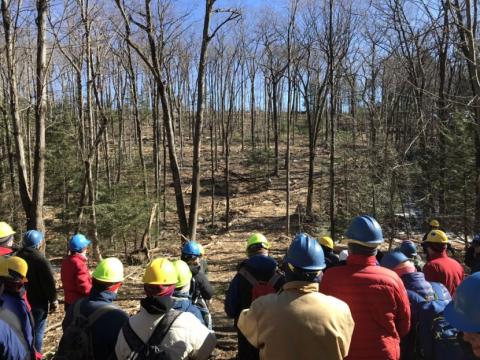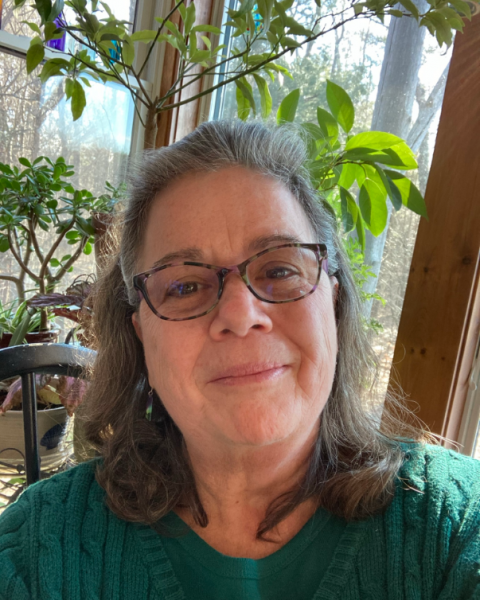Gaining Perspective - A New Steward Tours a Timber Harvest

On Saturday, February 9th, a walking tour of an active timber harvest in the Heald Tract in Wilton was conducted by a collaboration of foresters from the Society for the Protection of NH Forests, UNHCE County Extension foresters, a consulting forester, a wildlife biologist from US Fish and wildlife Services and one of the loggers. Dave Anderson of the Forest Society and of Something Wild podcast fame coordinated the event.
Despite cold temperatures and high winds, approximately 50 people hiked through the challenging terrain and were introduced to the goals and methods of the operation. As a local resident who has enjoyed the recreational trails in the area for many years and a 2018 Natural Resources Steward, I felt this opportunity was a perfect follow-up to our classes. While working on my nature journal last fall, I visited this site three times, including once with a friend who shared her extensive knowledge of the many fungi to be found.
Driving up to the site, I discovered two million dollars’ worth of equipment and several log piles sitting near where I would normally park my car. It was a bit of a jolt. Nevertheless, I was determined to keep an open mind. The tour guides acknowledged the disruption and mess and did not attempt to minimize the harvest impact to the area. Change can be difficult. It was explained that this harvest represents less than 8% of the total Heald property. We proceeded up the trail through several distinct cuts, stopping at each one for an explanation and chance to ask questions.
We learned that these are experimental cuts designed to guide future recommendations on creating rabbit habitat to hopefully restore the New England cottontail population, which is currently non-existent here. Part of this attempt includes encouraging regrowth of mountain laurel by opening the canopy. We learned that each cut has a different basal area or measurement of trees per acre. The NE cottontail has specific needs for protective habitat and the laurel meets those needs. My own experience with restoring laurel near home after the ice storm of 2008 is that laurel takes a long time to regrow. Ten years out, it is now about chest height, and I can see how this could be rabbit habitat. When one guest asked how the rabbits would return, we learned that they will not be introduced but the hope is they will migrate in and establish over time. I hope their goals are met, but as we all commented, everything eats rabbits and we wondered about predators.
The importance of creating corridors for wildlife was introduced. The Heald Tract is part of a corridor with the Sheldrick Forest Preserve to the north and the Souhegan Wildlife Management area, town and state forests to the south and east. In addition to rabbits we learned about the seed trees that were selected, trees that were intentionally girdled to provide habitat for other species and how the trees along the trails were protected with debris from damage by the equipment. We saw a water bar to manage runoff and sensitive areas selected for exclusion as well as avoidance of established hiking trails. A guest asked about cellar holes and other evidence of historical and cultural use of the property. These were found and left in place. The stone wall mapping project using LiDAR was mentioned.
We experienced the newly opened beautiful view while walking through the 12-acre abandoned apple orchard that had been clearcut. The wisdom of conserving this entire tract struck me as incredibly generous and forward-thinking as this easily could have been a residential development. The tour wrapped up back at the landing where the logger explained his equipment -- including the feller-buncher and a chipper that can handle 30-inch diameter logs among others -- how the logs are sorted, and the markets for various wood and chips. It was surprising to learn that the most valuable logs, red oak, are sent to Southeast Asia. Although financial specifics for this harvest were not disclosed, an example range for woodlot harvests was discussed for guests who may be considering their own harvest. UNH Extension county foresters welcome invitations by landowners for consultations at no charge.
I left feeling fortunate to have had this opportunity to understand the site management and goals. While it was a lot to process, it would have been a huge shock to discover the results without an explanation. After mud season, I expect to tour the harvest area more extensively, and anticipate that subsequent periodic visits will yield increasing signs of recovery and growth. I look forward to observing the many species of plants, pollinators and wildlife in the coming years.
For further details of the event, read Dave Anderson’s article, Heald Tract Timber Harvest Tour in Wilton: Timber Harvest Creates Wildlife Habitat and Provides Education Opportunities.
